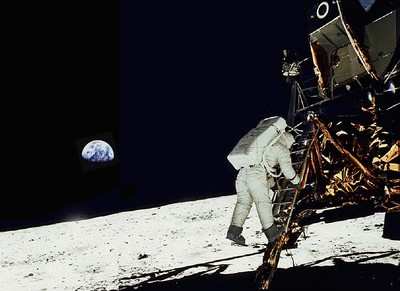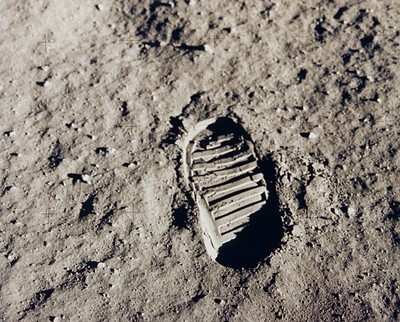Wed, Jul 21, 2004
35th Anniversary Of Apollo Moon Landing And NASA Is Looking
Ahead
The success of the Apollo 11 mission that landed NASA astronauts
Neil Armstrong and Edwin "Buzz" Aldrin on the Moon July 20, 1969,
was a defining moment that opened a new era in human history.
Today, as NASA marks the 35th anniversary of that first lunar
landing, the Marshall Space Flight Center in Huntsville (AL)
celebrates the role it played in the Apollo program. Under the
leadership of its first director, Dr. Wernher von Braun, the
Marshall Center developed the Saturn V rocket that carried our
astronauts to the Moon.

In a post-flight press conference, Armstrong called the flight
"a beginning of a new age." Even then, Astronaut Michael Collins --
who orbited the Moon in command module Columbia while his
colleagues made the historic Moon landing in their lunar module
Eagle -- talked about future journeys to Mars.
"The world experienced its greatest technology achievement when
NASA astronaut Neil Armstrong first stepped on the surface of the
Moon, taking a "giant leap" for humanity. That event captured the
imagination of the nation and inspired a new generation of space
explorers," said Marshall Center Director David King. "As we
observe this anniversary NASA is embarking upon a new journey of
discovery."

The Marshall Center is looking to the future, working to fulfill
its role in implementing the Vision for Space Exploration which
calls for a return to the Moon followed by human and robotic
journeys of discovery to other destinations in the solar
system.
The Marshall Center, with its expertise in space transportation
systems, space propulsion, microgravity science, space systems and
more, will play a significant role in fulfilling the Vision for
Space Exploration. Goals include safely returning the Space Shuttle
to flight; focusing the use of the Shuttle to complete assembly of
the International Space Station; and retiring the Shuttle as soon
as the Space Station is completed, around the end of the
decade.

NASA's longer terms goals, which will unfold over future
generations, include:
- A sustained and affordable human and robotic program to explore
the solar system and beyond. Extending human presence across the
solar system, starting with a human return to the Moon before the
year 2020, in preparation for human exploration of Mars and other
destinations.
- Developing innovative technologies, knowledge and
infrastructures to explore and support decisions about the
destinations for human exploration.
- Promoting international and commercial participation in
exploration to further US scientific, security and economic
interests.
More News
Terminal Radar Service Area Airspace surrounding designated airports wherein ATC provides radar vectoring, sequencing, and separation on a full-time basis for all IFR and participa>[...]
Very High Frequency (VHF) The frequency band between 30 and 300 MHz. Portions of this band, 108 to 118 MHz, are used for certain NAVAIDs; 118 to 136 MHz are used for civil air/grou>[...]
“From approximately November 2021 through January 2022, Britton-Harr, acting on behalf of AeroVanti, entered into lease-purchase agreements for five Piaggio-manufactured airc>[...]
Also: Virtual FLRAA Prototype, IFR-Capable Autonomous A/C, NS-32 Crew, Golden Dome Missile Defense Bombardier announced that the first production Global 8000 successfully completed>[...]
Aero Linx: The 1-26 Association (Schweizer) The Association’s goal is to foster the helpfulness, the camaraderie, and the opportunity for head-to-head competition that is fou>[...]
 ANN's Daily Aero-Term (05.29.25): Terminal Radar Service Area
ANN's Daily Aero-Term (05.29.25): Terminal Radar Service Area ANN's Daily Aero-Term (05.30.25): Very High Frequency (VHF)
ANN's Daily Aero-Term (05.30.25): Very High Frequency (VHF) Aero-News: Quote of the Day (05.30.25)
Aero-News: Quote of the Day (05.30.25) Airborne 05.23.25: Global 8000, Qatar B747 Accepted, Aviation Merit Badge
Airborne 05.23.25: Global 8000, Qatar B747 Accepted, Aviation Merit Badge ANN's Daily Aero-Linx (05.30.25)
ANN's Daily Aero-Linx (05.30.25)





